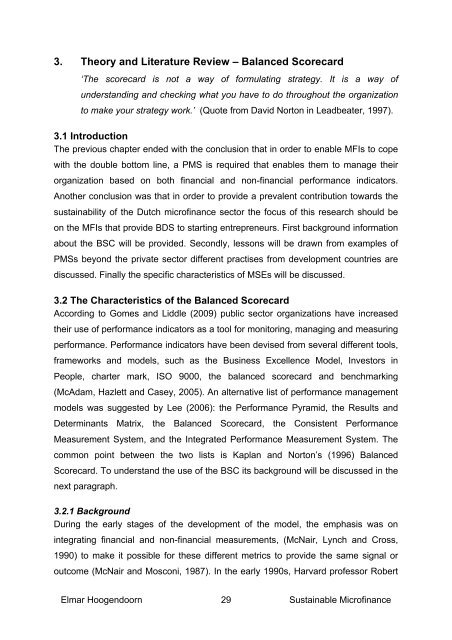Sustainable Microfinance - Balanced Scorecard's added value for ...
Sustainable Microfinance - Balanced Scorecard's added value for ...
Sustainable Microfinance - Balanced Scorecard's added value for ...
You also want an ePaper? Increase the reach of your titles
YUMPU automatically turns print PDFs into web optimized ePapers that Google loves.
3. Theory and Literature Review – <strong>Balanced</strong> Scorecard<br />
‘The scorecard is not a way of <strong>for</strong>mulating strategy. It is a way of<br />
understanding and checking what you have to do throughout the organization<br />
to make your strategy work.’ (Quote from David Norton in Leadbeater, 1997).<br />
3.1 Introduction<br />
The previous chapter ended with the conclusion that in order to enable MFIs to cope<br />
with the double bottom line, a PMS is required that enables them to manage their<br />
organization based on both financial and non-financial per<strong>for</strong>mance indicators.<br />
Another conclusion was that in order to provide a prevalent contribution towards the<br />
sustainability of the Dutch microfinance sector the focus of this research should be<br />
on the MFIs that provide BDS to starting entrepreneurs. First background in<strong>for</strong>mation<br />
about the BSC will be provided. Secondly, lessons will be drawn from examples of<br />
PMSs beyond the private sector different practises from development countries are<br />
discussed. Finally the specific characteristics of MSEs will be discussed.<br />
3.2 The Characteristics of the <strong>Balanced</strong> Scorecard<br />
According to Gomes and Liddle (2009) public sector organizations have increased<br />
their use of per<strong>for</strong>mance indicators as a tool <strong>for</strong> monitoring, managing and measuring<br />
per<strong>for</strong>mance. Per<strong>for</strong>mance indicators have been devised from several different tools,<br />
frameworks and models, such as the Business Excellence Model, Investors in<br />
People, charter mark, ISO 9000, the balanced scorecard and benchmarking<br />
(McAdam, Hazlett and Casey, 2005). An alternative list of per<strong>for</strong>mance management<br />
models was suggested by Lee (2006): the Per<strong>for</strong>mance Pyramid, the Results and<br />
Determinants Matrix, the <strong>Balanced</strong> Scorecard, the Consistent Per<strong>for</strong>mance<br />
Measurement System, and the Integrated Per<strong>for</strong>mance Measurement System. The<br />
common point between the two lists is Kaplan and Norton’s (1996) <strong>Balanced</strong><br />
Scorecard. To understand the use of the BSC its background will be discussed in the<br />
next paragraph.<br />
3.2.1 Background<br />
During the early stages of the development of the model, the emphasis was on<br />
integrating financial and non-financial measurements, (McNair, Lynch and Cross,<br />
1990) to make it possible <strong>for</strong> these different metrics to provide the same signal or<br />
outcome (McNair and Mosconi, 1987). In the early 1990s, Harvard professor Robert<br />
Elmar Hoogendoorn 29<br />
<strong>Sustainable</strong> <strong>Microfinance</strong>
















![Joint Report on Social Protection and Social Inclusion [2005]](https://img.yumpu.com/19580638/1/190x132/joint-report-on-social-protection-and-social-inclusion-2005.jpg?quality=85)
